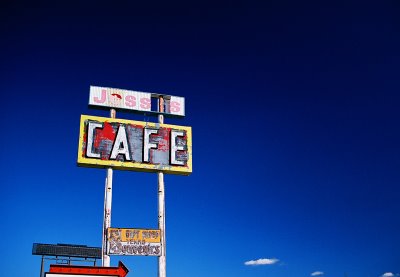 I can only speak for the stretch of old Route 66 east of Flagstaff, Arizona, but the state with the most kicks along Route 66 would have to be Texas. Where else can you find leaning water towers, art deco diners, giant crosses and ten cadillacs buried nose first in a field in a line matching that of the Cheops pyramid in Egypt? Not too many places, I would venture.
I can only speak for the stretch of old Route 66 east of Flagstaff, Arizona, but the state with the most kicks along Route 66 would have to be Texas. Where else can you find leaning water towers, art deco diners, giant crosses and ten cadillacs buried nose first in a field in a line matching that of the Cheops pyramid in Egypt? Not too many places, I would venture.At the same time, Texas has what I consider the saddest stretch of the old roadway. (Missouri has the kinkiest stretch; there must be a dozen billboards advertising adult book and video stores between Joplin and St. Louis, bringing new meaning to Missouri as the “Show Me” state, but I digress. Oklahoma wins for highest CPM – Casinos per mile – but I really have to get back on topic.)
The post-World War II travel boom made Route 66 a place of opportunity for entrepreneurs who sought ways to serve the growing number of travelers on the road and make a buck doing it. Unfortunately for many of them, the advent of the limited access highway in the late 1950s/early 1960s began to siphon off traffic. It was only a matter of time before the developing “get there quick” mindset of interstate travel combined with more and more highway business franchises to make mom-and-pop business survival untenable. Texas has a number of ghost towns or near-ghost towns visible from Interstate 40, the successor of Route 66.
I snapped a few pictures in the business district graveyard of Wildorado, Texas. Wildorado is a thriving farming and ranching community, but let’s just say its commercial zone has long since seen better days.
Click on picture to enlarge. Photograph © 2006 James Jordan.




No comments:
Post a Comment